Looking for a specific Sequence rule? | Setup | Playing the Game | Playing a Jack Card | Dead Cards | Losing a Card | Creating a Sequence | Winning the Game | FAQ | Components |
Objective
The objective of Sequence is to create one or two Sequences (five of your chips in a row) on the gameboard.
Setup
- Decide how you will play the game. This is dependent on the number of players.
- 2 players – Play individually with the blue and green chips
- 3 players – Play individually with the blue, green and red chips.
- 4+ players – Divide into teams so each team has the same number of players. There can be a maximum of three different teams. Players will sit so the teams will alternate when taking turns. If there are two teams use the blue and green chips. If there are three teams, use the red chips as well.
- Place the gameboard in the center of the table with enough room around the edges so each player can have a pile of chips and their own discard pile.
- Each player/team takes one of the colors of chips.
- Remove the Joker cards from the deck of cards. You do not use them in the game.
- Each player randomly cuts the deck to receive a card. The player that draws the lowest card becomes the dealer. Aces are considered high.
- The dealer shuffles the cards and deals cards face down to each player. The number of cards each player receives depends on the number of players.
- 2 players – 7 cards each
- 3-4 players – 6 cards each
- 6 players – 5 cards each
- 8, 9 players – 4 cards each
- 10, 12 players – 3 cards each
- The player to the left of the dealer starts the game. Play moves in a clockwise (left) direction during the game.
How to Play Sequence
On your turn you will play one of the cards from your hand. You can choose whichever card from your hand that you want.
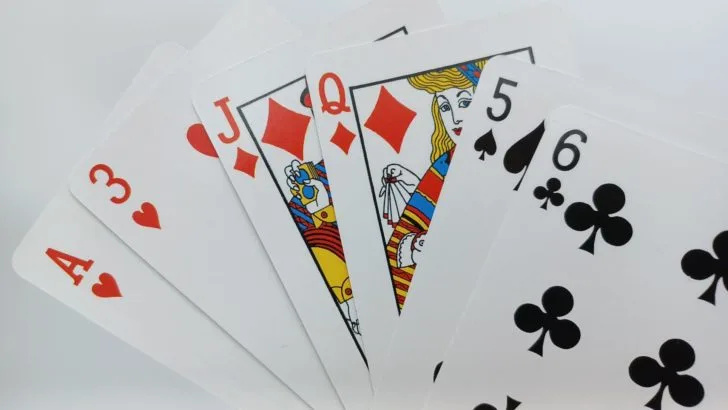
The card that you play will be one of the cards from a standard playing card deck. Each card in the deck is featured on two spaces on the gameboard (except for Jacks). You will choose one of the two corresponding spaces and place one of your chips on your chosen space.
You can choose to place your chip on either of the two spaces. If there is already a chip on one of the spaces though, you must choose the other space. Once a chip is placed it cannot be removed except when a one-eyed Jack is played.
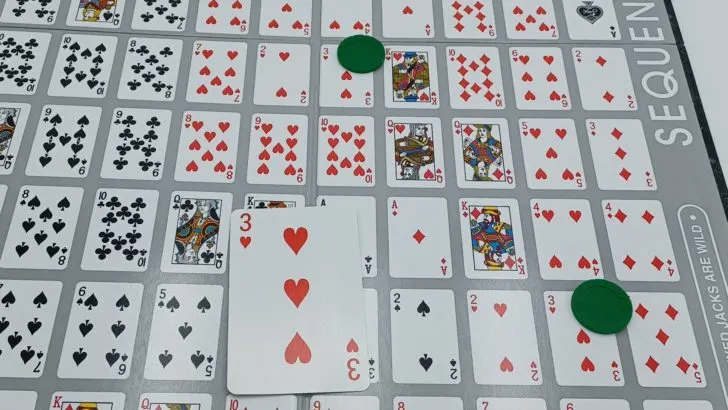
After placing one of your chips on one of the corresponding spaces, you will discard the card that you played. You should place the card into your own personal discard pile that the other players can see.
After you play one of your cards and place a chip, you will draw a card. If the draw deck ever runs out of cards, shuffle all of the cards in the individual players’ discard piles. Your turn then ends. Play passes to the next player in clockwise order.
Playing A Jack Card
While most of the cards in the deck correspond to a space on the gameboard, Jacks do not have their own spaces. Instead the Jack cards act as wilds.
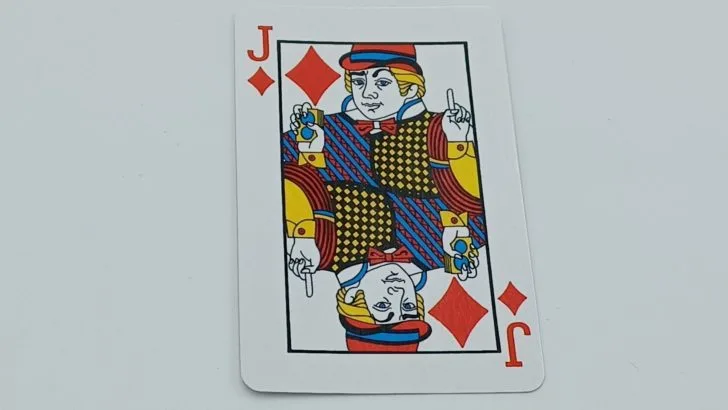
Two-Eyed Jacks
When you play a two-eyed jack card, you will play it like a normal card. A two-eyed Jack allows you to place one of your chips on any open space on the gameboard.
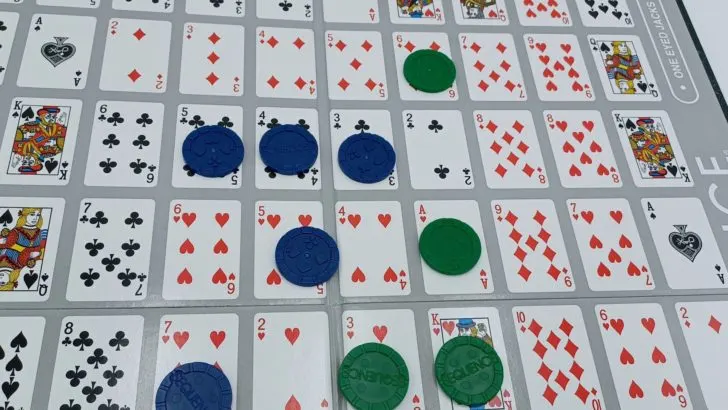
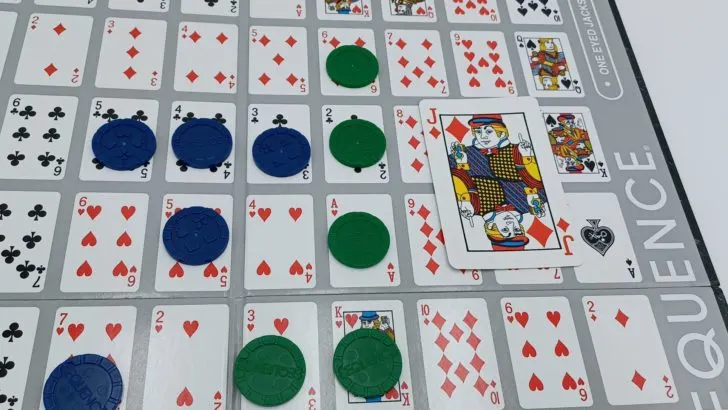
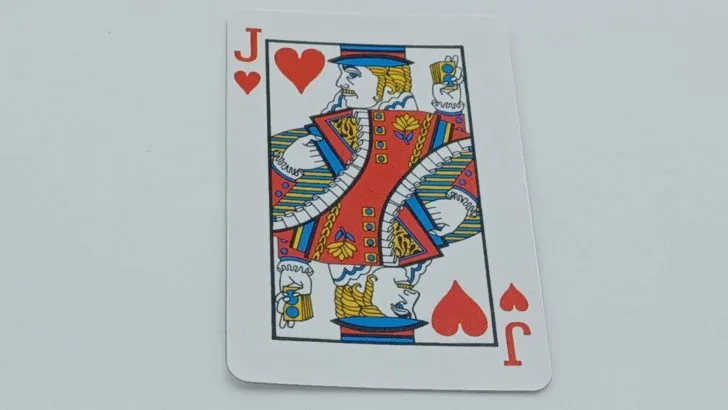
One-Eyed Jacks
One-eyed jacks are anti-wild cards. Instead of placing a chip on a space of your choice, you instead get to remove a chip placed by an opponent. You can choose to remove a chip from any space with one exception. You may not remove a chip if it is part of an already completed Sequence. The corresponding space is now open to all of the players. After removing a chip from the gameboard, your turn ends immediately. You do not get to place one of your chips on the space that you just cleared.
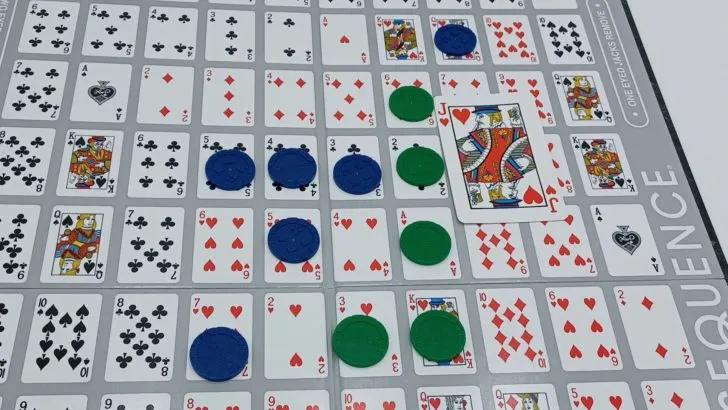
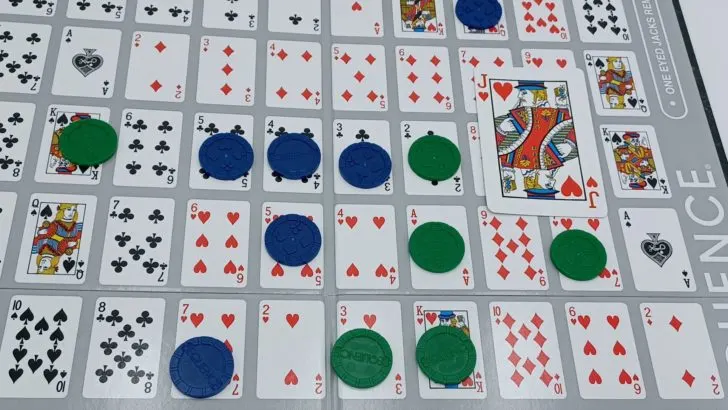
Dead Cards
Sometimes you will have cards in your hand that you can no longer play. This happens when both of the corresponding spaces on the gameboard have a chip on them. These cards are referred to as “dead cards”.
Each turn you may discard one of the dead cards from your hand. You will tell the other players that it is a dead card. Draw a new card to replace the card you discarded. You may only do this once per turn.
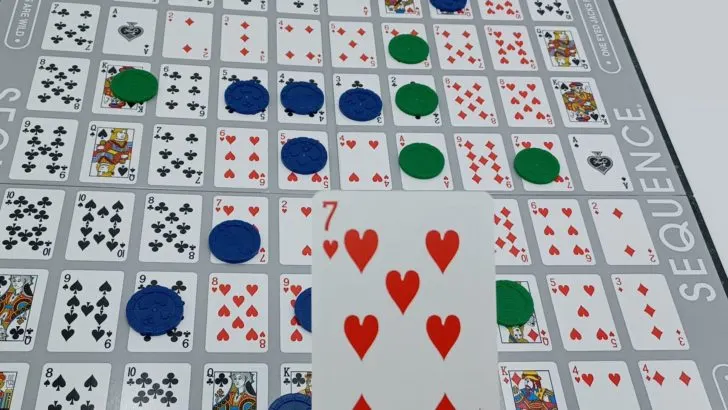
You will then take your normal turn.
Losing A Card
At the end of your turn you will draw a card to add to your hand.
Should you forget to draw a card and the next player takes their turn and draws their card, you forfeit the card that you could have drawn. You will play the rest of the game with less cards in your hand.
You can also lose a card by discussing strategy with your teammates. At no time during the game can you make a comment to your teammate telling them what they should/shouldn’t do on their turn. If you advise your teammate, all players on your team have to discard one of the cards from their hand. Each player chooses which card they want to discard. Each of these players will have one less card in their hand for the rest of the game.
Creating A Sequence
The goal of the game is to create Sequences. To create a Sequence you need to place five of your colored chips in a row on the gameboard. You may create one vertically, horizontally, or diagonally. Once you create a Sequence, it will remain one for the rest of the game. There is nothing you can do to erase/stop one that has been created.
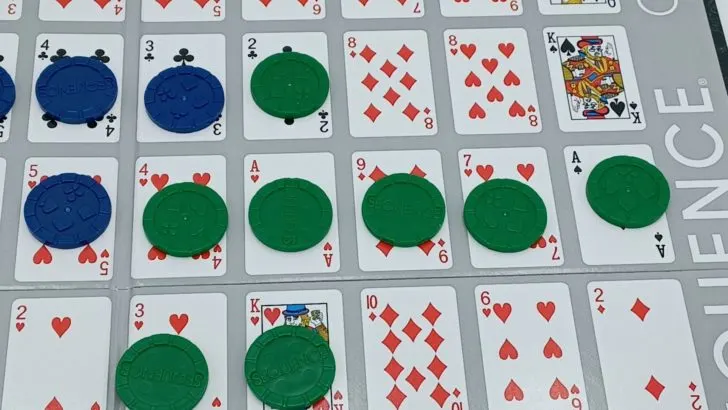
Each corner of the gameboard has a chip printed on it. Each player will treat these spaces as if one of their colored chips were placed on them. Multiple players can use the same corner space to represent their own color. You can use one of the corner spaces as one of the five spaces needed to create a Sequence.
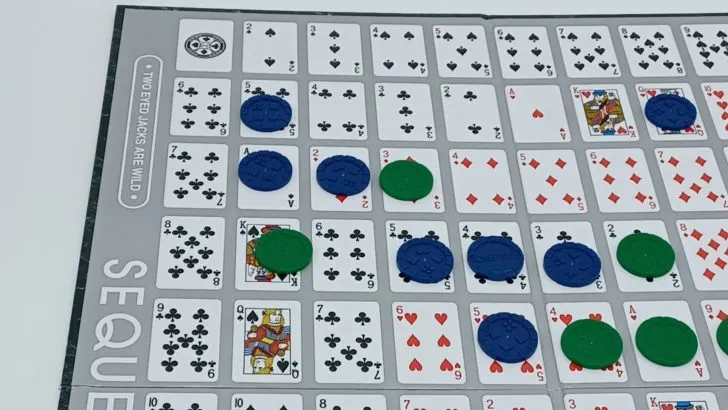
Winning the Game
The first player/team to create enough Sequences wins the game. The number of Sequences you need to create to win the game depends on the number of players/teams.
- 2 players/teams – You need two Sequences to win the game.
- 3 players/teams – You need one Sequence to win the game.
If you need two Sequences to win the game, you can use one of your spaces in both of your Sequences.
Once you acquire enough Sequences to win the game, you win immediately.
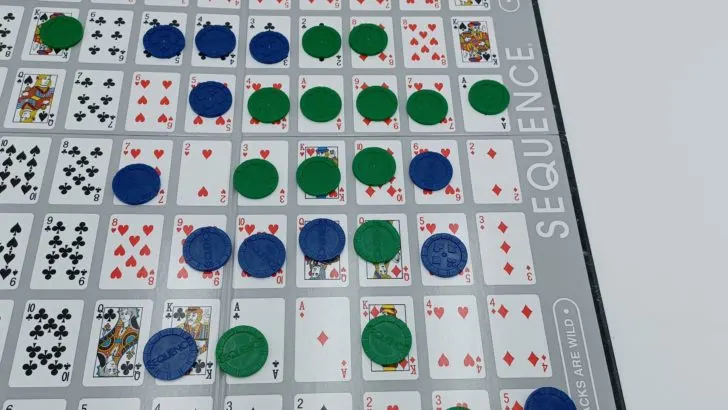
Sequence FAQ
If you have any questions about how to play the game, leave a comment below on this post. I will try to answer any questions asked as best and as quickly as possible.
I created a Sequence on a previous turn but didn’t notice it before the next player took their turn. Can I claim it on my next turn? If I have enough Sequences to win but don’t notice until the next player’s turn, do I have to wait for my next turn to win?
There have been some tweaks to the rules over the years, but I have not seen a version that specifically says that you have to claim a Sequence for it to count. Once it is completed, you get credit for it even if you forget to tell the other players. It is usually best to alert the other players though.
The question then becomes if you notice you have enough Sequences to win on another player’s turn. This isn’t addressed in the rules. I would say that at any time you notice that you have enough Sequences to win the game, you immediately win. Since there is no requirement to declare that you created one, I see no reason why you can’t win whenever you notice that you have enough Sequences to win the game. If two players both have enough to win, whoever created enough to win first should be declared the winner.
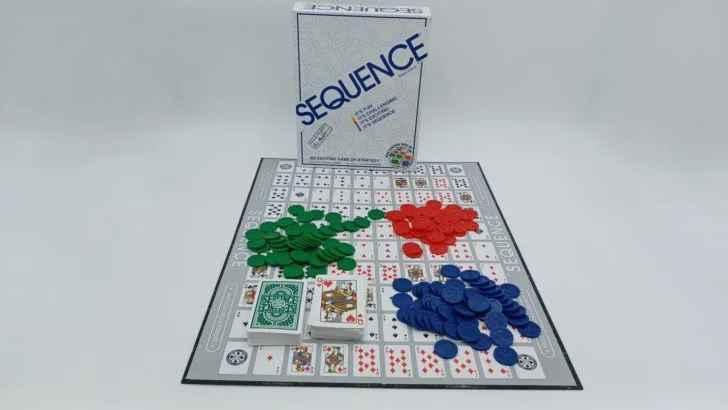
Components
- Game board
- 50 green chips
- 50 blue chips
- 35 red chips
- 104 cards
- Instructions
Year: 1982 | Publisher: Goliath Games, Hasbro, Jax Ltd., Milton Bradley | Designer: Doug Reuter
Genres: Abstract, Card, Family
Ages: 7+ | Number of Players: 2-12 | Length of Game: 20-30 minutes
Difficulty: Light | Strategy: Light | Luck: Moderate
Components: game board, 50 green chips, 50 blue chips, 35 red chips, 104 cards, instructions
Where to Purchase: Amazon, eBay Any purchases made through these links (including other products) help keep Geeky Hobbies running. Thank you for your support.
For more board and card game rules/how to plays, check out our complete alphabetical list of card and board game rules posts.

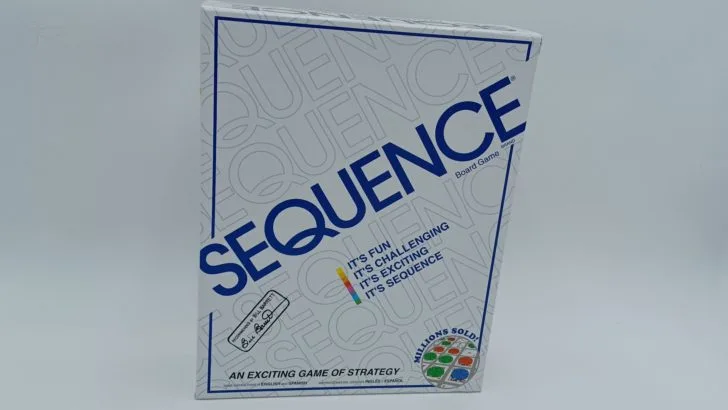
Brenda Cormack
Thursday 8th of June 2023
I enjoy getting 2 Sequences connected at a corner at the same time anywhere on the board and I call Double Sequences and win the game! I have gotten 3 at the same time too, have you heard of very many people doing this? And sometimes I find to do this I want to remove my own chip with a one eyed Jack, is that legal? I don’t do it because we have not see this in the rules but I sure want to at times! This is playing with 2 people. We play an average of two to 4 games a day! We love it!!!
Eric Mortensen
Thursday 8th of June 2023
Getting two sequences at the same time is probably the most exciting way of winning Sequence. I am not sure how common it is to get two Sequences at the same time though.
As for your question about using the One Eyed Jack to remove one of your own chips. The rules do state to use the card to remove one of your opponents chips. Therefore following the official instructions you probably wouldn't be able to remove your own chip. I am a believer in using house rules if all of the players agree to use them. So if you want to play the game where you can remove your own chips and the other player agrees, I see no reason why you couldn't.
Matt
Friday 31st of March 2023
If you don't call a sequence and another player takes a turn and selects a card, can you call sequence on your turn?
Eric Mortensen
Saturday 1st of April 2023
You should be able to call a sequence on your next turn. Once you have created a sequence it remains a sequence for the rest of the game. I am not sure if it is even required that you call out when you make a sequence. I believe the official instructions do not mention that you have to specifically call out when you create a sequence. It is probably a good idea to do so though to let the other players know.
There are two times where I think the situation you described could present an issue. First if another player plays a one-eyed jack card and tries to take away one of the chips that are part of a sequence. In a case where this would happen, the players would have to agree to how it would be handled. Based on the rule that you can't take a chip away from a sequence, I believe the player probably shouldn't be able to take a chip that would break up a sequence.
The second situation would be if the sequence you didn't call on your previous turn would have won you the game. Then the next player creates a sequence on their turn which would win them the game. In this case you would have to decide which player ultimately won the game. I personally would say the first player (who didn't call out the sequence) would win since they met the winning conditions first.